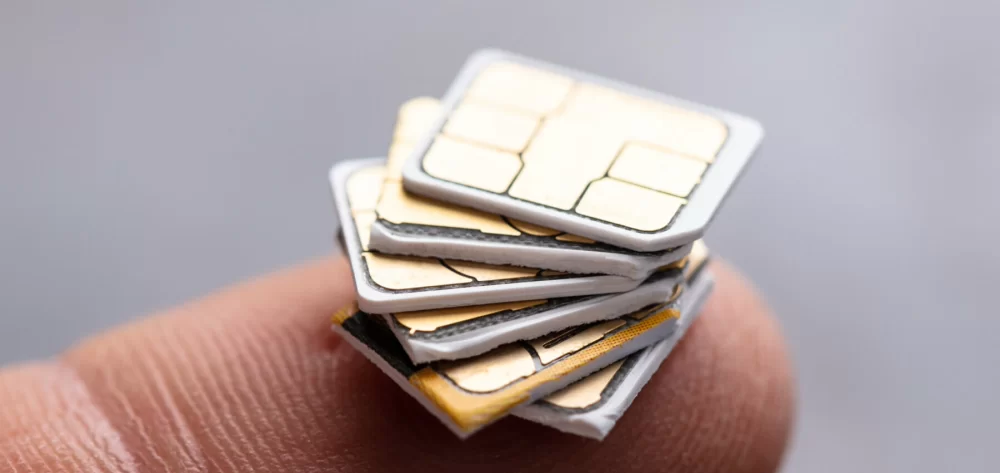What is multi-SIM?
With multi-SIM – also called multi-device – you get two or more SIM cards which are all linked to just one mobile plan. That enables you to use the telecom services provided by your plan from more than one device. In some cases, it is also possible to make and receive calls at the same phone number on several different devices. All the SIM cards share the same phone number.
Multi-SIM should not be confused with supplemental SIM cards which each have their own phone number. The SIM cards offered to customers as part of family or loyalty offers also are not normally multi-SIM cards.
What is the difference between multi-SIM, dual-SIM and eSIM?
These three terms are often confused with each other. But they are in no way directly related. Here is a short clarification of these commonly-confused terms:
- Multi-SIM: You receive two or more SIM cards which share the same phone number. The services and allowances included in the mobile plan can be used on all the devices equipped with one of these SIM cards.
- Dual-SIM: A dual-SIM device can store two different SIMs. That enables you to use just one device for two different phone numbers (a private number and a business number, for example).
- eSIM: An eSIM stores SIM information completely digitally, rather than on a SIM card. The SIM information is loaded to the device via the Internet.
What uses do multi-SIMs have?
With multi-SIM, you can use your mobile plan for a second phone, a smart watch, a tablet, or a laptop, in addition to your main device.
Multi-SIMs are often used for smart watches. This can enable you to use online services or make calls from your watch, among other things.
Multi-SIM can also be used to get online with your tablet or laptop without having to use a mobile hotspot (tethering your devices to your phone, for example). This is possible if your device has its own SIM card slot or eSIM functionality.
Which Swiss telecom companies offer multi-SIM?
Only a few Swiss telecom companies offer multi-SIM. At this time, multi-SIM is only offered by these mobile service providers:
- Coop Mobile
- Digital Republic
- Galaxus Mobile
- iWay
- M-Budget Mobile
- Sunrise
- Swisscom
- Quickline
- Wingo
All other Swiss service providers do not let you use more than one SIM with the same mobile plan. It is interesting to note that Salt, the third-largest Swiss mobile service provider, does not offer multi-SIM. Most budget services, including Aldi Suisse Mobile, Gomo, and Yallo, also do not have multi-SIM offers.
Which mobile plans have a multi-SIM option?
Only relatively few mobile plans include the option of using multi-SIM. You can easily find out which offers have multi-SIM services by selecting the “supplemental SIM cards” filter under “services” in the interactive Swiss mobile plan comparison.
What does multi-SIM cost?
You should count on paying between 2 and 10 francs per month per additional SIM card. There are major differences between multi-SIM offers, particularly insofar as the purposes they are designed for, and their Internet connection speeds.
On one side of the spectrum are supplementary SIMs with throttled Internet speeds of 1 Mbps or less. These offers are best-suited for use in fitness trackers and smartwatches.
| Service provider |
Product |
Speed |
Monthly fee |
| Sunrise |
We Connect Extra SIM Track |
0.5 Mbps |
CHF 2.00 |
| Swisscom |
Multi Device Trackers & Sensors |
0.4 Mbps |
CHF 3.00 |
| Swisscom |
Multi Device Watches & Wearables |
1 Mbps |
CHF 5.00 |
| Wingo |
Second SIM |
1 Mbps * |
CHF 5.00 |
| M-Budget Mobile |
Multi SIM |
1 Mbps |
CHF 6.90 |
| Coop Mobile |
Multi SIM |
1 Mbps |
CHF 6.90 |
* Without activating the supplemental Full Speed 5G option.
On the other end of the spectrum are high-speed offers whose Internet speeds typically match that of your mobile plan.
| Service provider |
Product |
Speed |
Monthly fee |
| Digital Republic |
Watch SIM Option |
Identical to mobile plan |
CHF 4.00 |
| Galaxus Mobile |
Multi SIM |
Identical to mobile plan |
CHF 5.00 |
| Quickline |
Extra SIM Watch |
Identical to mobile plan |
CHF 5.00 |
| Quickline |
Extra SIM |
Identical to mobile plan |
CHF 5.00 |
| Sunrise |
We Connect Extra SIM Watch |
Identical to mobile plan |
CHF 5.00 |
| iWay |
Multi-SIM |
Identical to mobile plan |
CHF 10.00 |
| Sunrise |
We Connect Extra SIM Surf |
100 Mbps |
CHF 10.00 |
| Swisscom |
Multi Device Smartphones & Tablets |
Identical to mobile plan |
CHF 10.00 |
| Swisscom |
Multi Device Cars & Mobikuties |
Identical to mobile plan |
CHF 10.00 |
| Wingo |
Second SIM and Full Speed 5G |
2000 Mbps |
CHF 15.00 * |
* Accounts for the CHF 10.00 fee for the Full Speed 5G option
Note that the mobile plans which offer multi-SIMs are often much more expensive than mobile plans from budget brands, especially if you get the latter during special promotions. Recently, a number of budget mobile service providers have begun offering the multi-SIM service. But the Internet speeds are typically very low. Only a few service providers offer multi-SIMs with faster Internet connections.
Some Swisscom plans include three or four supplemental multi-SIM cards at no additional cost. Galaxus Mobile’s multi-SIM fees are waived for the first 12 months.
How many SIM cards do I get?
The number of supplemental multi-SIMs you can get varies between service providers. You receive between two and ten secondary SIM cards, depending on the mobile service provider.
| Anbieter |
Maximum number of secondary SIM cards |
| Coop Mobile |
3 |
| Galaxus Mobile |
4 |
| iWay |
2 |
| M-Budget Mobile |
3 |
| Sunrise |
5 |
| Swisscom |
10 |
| Quickline |
4 |
| Wingo |
3 |
Can I make calls using a multi-SIM card?
That depends on your mobile service provider. Swisscom and Wingo let you make phone calls from all devices. Sunrise only lets you make calls from a smart watch using a multi-SIM designated for smart watches. Galaxus lets you use a key combination on your phone to select which of your devices will be used for phone calls. You can only make and receive phone calls on the selected device.
Can I use multi-SIM cards with any mobile plan or prepaid offer?
That depends on which of mobile service provider you use. In many cases, multi-SIM functionality is only included in specific mobile plans from a certain telecom service provider. Normally, it is included in more expensive mobile plans.
Multi-SIM is generally not included in prepaid mobile offers.
Are multi-SIMs also available as eSIMs?
Yes, multi-SIMs can typically also be used in devices which use eSIMs.
Which devices support multi-SIM?
Multi-SIMs can generally be used in any device which has a SIM card slot. If your mobile service provider also offers multi-SIM cards as eSIMs, you can use these eSIMs in any device which supports eSIM.
Multi-SIMs are typically used for these devices:
- Smartphones
- Smart watches
- Fitness trackers
- Tablets
- Laptops
But not all devices have a SIM card slot or eSIM functionality. For example, most laptops do not support SIMs at all. Make sure to check whether your device even supports SIMs before you order a multi-SIM card.
Some mobile service providers offer secondary SIM cards that can only be used for specific devices. For example, secondary SIM cards from Digital Republic can only be used with the Apple Watch and Samsung's Galaxy watches. The Car's & Mobilities option from Swisscom, which currently can only be used with cards from BMW, is another example.
Can multi-SIM cards be used for mobile roaming?
Swisscom and Wingo let you remain connected while traveling outside of Switzerland. With Sunrise, whether or not you can use multi-SIMs for roaming depends which product you use: The Extra SIM Track and Extra SIM Surf options support mobile roaming, but the Extra SIM Watch option does not. Digitec Connect only lets you make roaming phone calls using multi-SIMs, but data roaming is disabled. The company says it is working with manufacturers and network operators to enable data roaming in the future.
What are the alternatives to multi-SIM?
You can connect a smart watch, tablet, or laptop to the Internet via the mobile hotspot option on your phone. The downside is that your devices have to remain connected to your phone, and your phone’s battery will drain much faster when hotspot tethering is active.
Another alternative is to get a separate mobile plan or prepaid mobile offer for use with your secondary device. In many cases, this option works out cheaper than using multi-SIM services because the mobile plans which support multi-SIM are typically expensive.
What are the advantages of multi-SIM?
The main advantage of multi-SIM is that you can connect devices like smart watches, tablets, and laptops directly to the Internet without having to use hotspots. But you get this exact same advantage if you use SIM cards which are not all linked to one mobile plan.
A unique feature is that all devices share the same phone number, so you can be reached and make calls from any device. That can be an advantage if you make a lot of phone calls. For example, if you use a damage-resistant phone while at work, and a niftier phone during your leisure time, using a multi-SIM lets you avoid having to constantly shift your SIM card from one phone to the other. Multi-SIMs can also be beneficial when, for example, you only have your smart watch or another device other than your phone with you, because you will still be reachable at your regular phone number.
What are the disadvantages of multi-SIMs?
Certain kinds of mobile apps – primarily Whatsapp and apps which come with financial services – can often only be used on a single device. If you use Whatsapp, for example, you will have to decide which of your devices you want to use that app with.
The mobile plans which support multi-SIM are often relatively expensive compared to other offers. Tablets and laptops with SIM slots are also usually more expensive than similar devices which do not have that feature.
More on this topic:
Compare Swiss mobile plans now

 Deal of the Day
Deal of the Day 




